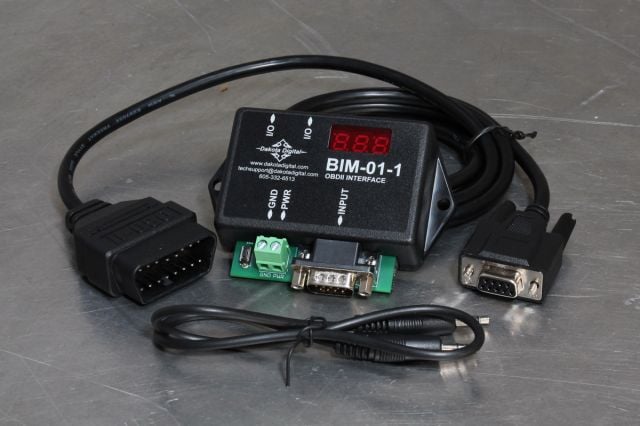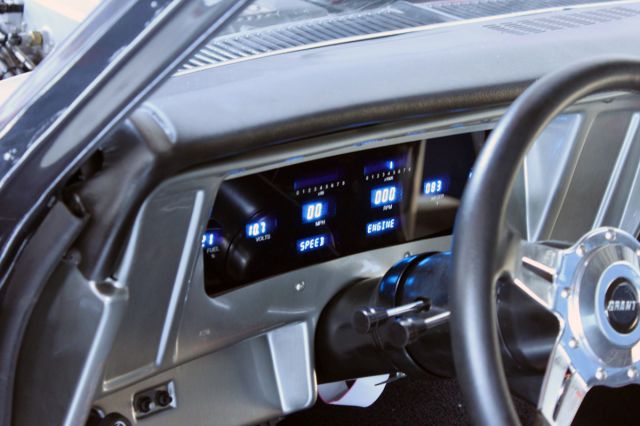 Dakota Digital has been making gauges and instrument clusters for classic cars, street rods, and muscle cars for decades, and their new line of VHX instruments have been a huge hit with the restomod crowd. Their VFD instruments (Vacuum Florescent Display) have a cool blue or teal digital readout of the engine’s functions, while the VHX series combines the classic look of analog gauges with the accuracy of digital input. Both give your custom car a great look when it comes to instrumentation.
Dakota Digital has been making gauges and instrument clusters for classic cars, street rods, and muscle cars for decades, and their new line of VHX instruments have been a huge hit with the restomod crowd. Their VFD instruments (Vacuum Florescent Display) have a cool blue or teal digital readout of the engine’s functions, while the VHX series combines the classic look of analog gauges with the accuracy of digital input. Both give your custom car a great look when it comes to instrumentation.
While these gauges have worked great for engine swaps of years gone by, the new surge of LS engine swaps meant that Dakota Digital had to come up with a way to get the newer OBD II ECMs to communicate with the gauges, and they’ve done it with their new OBD II interface module (BIM-01-1).
Years ago, a V8 swap meant putting a V8 in a car that typically didn’t come with one, or replacing a small block with a big block. Before the days of EFI and computers, this swap was fairly simple: engine mounts and a few electrical connections were the bulk of the swap.
The major concerns were what size engine, and what size carburetor to use. Gauges were a lot easier to connect back then, and aftermarket gauges typically included the sender that works with that gauge.
But with the popularity of the LS engine swaps into classic cars, like our LSA swap into a 1971 Nova that we call Project Swinger, there are other considerations that need to be made. You have to retain all of the factory senders, because they are needed to communicate with the ECM.
Unfortunately, many classic cars were built with a limited number of gauges, and some only had ‘idiot’ lights. With an LS swap, there really wasn’t any way to get some of the engine’s important information from the computer to the factory gauges. Aftermarket gauges will only read information from the senders that are included with them, but your ECM most likely doesn’t work with aftermarket senders.
The data link cable connects your OBD II ECM to the interface module, and the small cable connects the module to the control box for your Dakota Digital instrument cluster.
As engine swaps got more complex, there was a need for an expansion module to connect the OBD II ECM to Dakota Digital gauges, and the BIM-01-1 interface module does just that. The best part about the interface is that it plugs directly into the engine diagnostic port coming from your OBD II ECM.

The diagnostic port for the OBD II ECM provides all of the information for your VHX or VFC3 rev. G control box.
Fortunately, you can get harnesses with all of the proper connectors needed for the factory senders and the ECM, but if you want your Dakota Digital gauges to work properly you have to get the information directly from the ECM, not the factory senders. The interface module is a simple connection, too, because you don’t have to run several wires back out to your engine like you would for a typical gauge installation.
With the OBD II Interface Module there is a positive and ground wire to hook up, a data link cable that connects the interface module and the diagnostic port, and finally a connection is made from the I/O port on the module to the VHX or VFD3 rev. G control box.
Greg Karpe, Product Specialist at Dakota Digital, said, “The way to tell if you have the later control box is that it’s plastic. The earlier revisions had a brushed aluminum housing on the control box.”
The BIM-01-1 decodes the information from the ECM, which requires a complete set of functioning OEM sensors. The connections are simple, and this interface module is the only way to get your ECM to communicate with the control box, providing the data is available and accurate from the ECM. In addition to speed, tachometer, and engine temperature, you can also get intake air temperature, transmission temperature, ambient air temperature and gear position. Check out Dakota Digital’s web site to find out more about their expansion modules and to see if they have a cool set of gauges for your car!




















